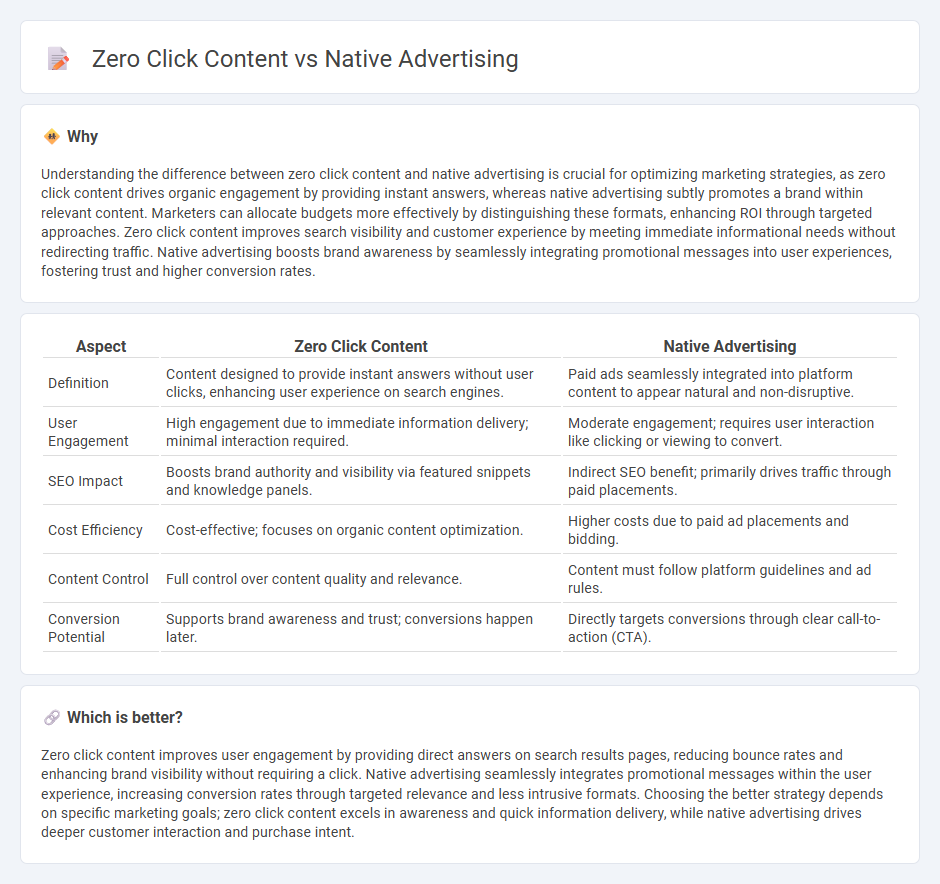
Zero-click content enhances user experience by delivering immediate answers within search engine results, reducing the need for clicks and keeping engagement on the platform itself. Native advertising integrates promotional messages seamlessly into the content feed, matching the format and style to increase brand visibility without disrupting user interaction. Explore the distinctions between zero-click content and native advertising to optimize your digital marketing strategy effectively.
Why it is important
Understanding the difference between zero click content and native advertising is crucial for optimizing marketing strategies, as zero click content drives organic engagement by providing instant answers, whereas native advertising subtly promotes a brand within relevant content. Marketers can allocate budgets more effectively by distinguishing these formats, enhancing ROI through targeted approaches. Zero click content improves search visibility and customer experience by meeting immediate informational needs without redirecting traffic. Native advertising boosts brand awareness by seamlessly integrating promotional messages into user experiences, fostering trust and higher conversion rates.
Comparison Table
| Aspect | Zero Click Content | Native Advertising |
|---|---|---|
| Definition | Content designed to provide instant answers without user clicks, enhancing user experience on search engines. | Paid ads seamlessly integrated into platform content to appear natural and non-disruptive. |
| User Engagement | High engagement due to immediate information delivery; minimal interaction required. | Moderate engagement; requires user interaction like clicking or viewing to convert. |
| SEO Impact | Boosts brand authority and visibility via featured snippets and knowledge panels. | Indirect SEO benefit; primarily drives traffic through paid placements. |
| Cost Efficiency | Cost-effective; focuses on organic content optimization. | Higher costs due to paid ad placements and bidding. |
| Content Control | Full control over content quality and relevance. | Content must follow platform guidelines and ad rules. |
| Conversion Potential | Supports brand awareness and trust; conversions happen later. | Directly targets conversions through clear call-to-action (CTA). |
Which is better?
Zero click content improves user engagement by providing direct answers on search results pages, reducing bounce rates and enhancing brand visibility without requiring a click. Native advertising seamlessly integrates promotional messages within the user experience, increasing conversion rates through targeted relevance and less intrusive formats. Choosing the better strategy depends on specific marketing goals; zero click content excels in awareness and quick information delivery, while native advertising drives deeper customer interaction and purchase intent.
Connection
Zero click content leverages native advertising by seamlessly integrating promotional material within organic user experiences, reducing the need for external clicks. Native ads blend with platform content, increasing engagement and brand awareness by providing immediate value or information directly on search results or social feeds. This synergy enhances marketing effectiveness by capturing audience attention without disrupting the user journey.
Key Terms
Content Integration
Native advertising seamlessly blends promotional content with organic media, enhancing user engagement by matching the platform's style and tone. Zero click content provides immediate answers within search results, reducing clicks but emphasizing direct user value through concise information. Explore more to understand how strategic content integration maximizes both user experience and marketing impact.
User Engagement
Native advertising seamlessly integrates promotional content within user experiences, enhancing engagement by aligning with the platform's natural format and reducing ad fatigue. Zero click content captivates users by delivering valuable information directly within search results, increasing interaction without requiring website visits. Explore deeper insights on how these strategies transform user engagement and drive marketing success.
Traffic Acquisition
Native advertising integrates promotional messages seamlessly within content platforms, driving high-quality traffic by matching the style and tone of the host site, which increases user engagement and click-through rates. Zero click content captures user interest by providing immediate answers or valuable information directly on the search results page, reducing the need for clicks but potentially limiting site traffic acquisition. Explore effective strategies to balance native advertising and zero click content for optimized traffic acquisition and enhanced user experience.
Source and External Links
What is Native Advertising - How it Works - Outbrain - Native advertising is paid media designed to match the look, feel, and function of the media format where they appear, blending in with editorial content to engage users more effectively than traditional ads.
What is native advertising? - Adjust - Native advertising offers non-intrusive, highly engaging paid content that matches the native format of a platform, resulting in higher click-through rates, user retention, and better ROI compared to traditional ads.
The Good, the Bad, and the Ugly of Native Advertising - Clearcode - Native ads are designed to look and behave like natural site content, providing better user engagement and campaign ROI by seamlessly integrating into the user experience instead of appearing as obvious advertisements.
 dowidth.com
dowidth.com